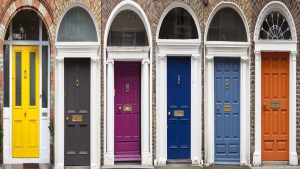By Erica Rascón on July 3, 2020 in News
Is it possible to shorten the fallout of an economic crisis? Researchers at the University of Maryland believe it’s possible. Preventative measures can mitigate the impact of economic downturns by creating neighborhoods that are naturally resilient to variances in economic performance. Diverse neighborhoods, researchers propose, can decrease the rate of foreclosures and sales before and after economic crises strike.
What puts homogeneous neighborhoods at risk?
After World War II, planners developed neighborhoods with a single income bracket in mind. Like their urban counterparts, these planned communities segregated individuals and families based on their earning power and, occasionally, place of employment.
During difficult economic times, neighborhoods that lack diversity are prone to clusters of foreclosures and sales before and after the peak of the recessionary activity. Neighborhoods that relied heavily on one employer also suffered severe spikes in financial difficulties. The homogeneous nature of these neighborhoods left them vulnerable. If one company or industry suffered, the entire neighborhood suffered as well.
Neighborhoods with high concentrations of bank-owned and for-sale homes take longer to recover from economic downturns. Residents that struggled with mortgages may have postponed home maintenance in an effort to conserve resources for mortgage payments. As a result, many foreclosed homes show signs of physical deterioration. Additional damages may occur during the eviction process. Neighborhoods with high concentrations of foreclosures and sales experience the devaluation of nearby homes. Additionally, as lender confidence decreases, so will investment in the area.
To create neighborhoods that are more resilient in the face of economic trouble, University of Maryland researchers suggest that developers shift to mixed-income housing models.
Uncovering the economic disadvantages of homogeneous neighborhoods
The study began by creating a data set that logged zoning and foreclosures across 14 metropolitan statistical areas (MSA). Researchers selected MSAs from throughout the Unites States that offered thorough data on zoning and population. The MSAs also demonstrated positive population growth or supply-constrained housing markets before the 2008 recession.
Learn more about the University of Maryland research here.
After gathering and analyzing the data, researchers unveiled a correlation between neighborhood diversity and economic fortitude. Four key findings stand out in the report:
- Homogeneous neighborhoods demonstrated higher foreclosure and sales rates
- The predominance of a single or few employers, development density and street accessibility were also indicators of high foreclosure rates
- The depth of that correlation between diversity and economic hardiness varied by statistical model and by region
- Though homogeneous housing is linked to higher foreclosure and sales rates during economic downturns, “the share of borrowers, the share of Hispanic residents, and vacancy rate are stronger drivers of both foreclosure and sales rates”
The benefits of mixed-income housing
Housing Matters, an Urban Institute Initiative, defines diverse housing as communities that include a blend of single-family, duplexes, and multifamily housing on different scales. Such neighborhoods welcome individuals and families from all walks of life, various employment industries and income levels.
The University of Maryland report suggests that housing diversity can mitigate the effects of an economic downturn. As residents represent a blend of industries and sectors, no single point of weakness will impact the entire neighborhood. In long-term and complete economic crises, cities with more diverse neighborhoods will show fewer clusters of foreclosures and sales.
By developing diverse neighborhoods, cities can be proactive about economic resilience. Planners may strengthen their territories—and theoretically, the nation—by disbursing foreclosures and sales. It is the high concentration of distressed properties that slows economic recovery.
Planners may consider housing diversity at both neighborhood and jurisdiction levels. The authors suggest that homeowners who are concerned about property values may be reassured that housing diversity contributes to long-term financial stability for the community.


